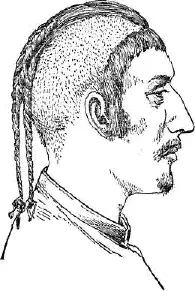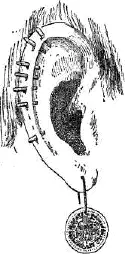Girls from seven to ten years old are clothed with only a petticoat, and boys about the same age wear only a shirt. Younger children are, as a rule, entirely naked. If clothed at anytime, it is only during exceptionally cool weather or when taken by their parents on a journey to the homes of the palefaces.
Table of Contents
The love of personal adornment shows itself among the Seminole as among other human beings.

Manner of wearing the hair.
Table of Contents
The coarse, brilliant, black hair of which they are possessors is taken care of in an odd manner. The men cut all their hair close to the head, except a strip about an inch wide, running over the front of the scalp from temple to temple, and another strip, of about the same width, perpendicular to the former, crossing the crown of the head to the nape of the neck. At each temple a heavy tuft is allowed to hang to the bottom of the lobe of the ear. The long hair of the strip crossing to the neck is generally gathered and braided into two ornamental queues. I did not learn that these Indians are in the habit of plucking the hair from their faces. I noticed, however, that the moustache is commonly worn among them and that a few of them are endowed with a rather bold looking combination of moustache and imperial. As an exception to the uniform style of cutting the hair of the men, I recall the comical appearance of a small negro half breed at the Big Cypress Swamp. His brilliant wool was twisted into many little sharp cones, which stuck out over his head like so many spikes on an ancient battle club. For some reason there seems to be a much greater neglect of the care of the hair, and, indeed, of the whole person, in the northern than in the southern camps.
The women dress their hair more simply than the men. From a line crossing the head from ear to ear the hair is gathered up and bound, just above the neck, into a knot somewhat like that often made by the civilized woman, the Indian woman’s hair being wrought more into the shape of a cone, sometimes quite elongated and sharp at the apex. A piece of bright ribbon is commonly used at the end as a finish to the structure. The front hair hangs down over the forehead and along the cheeks in front of the ears, being what we call “banged.” The only exception to this style of hair dressing I saw was the manner in which Ci-ha-ne, a negress, had disposed of her long crisp tresses. Hers was a veritable Medusa head. A score or more of dangling, snaky plaits, hanging down over her black face and shoulders gave her a most repulsive appearance. Among the little Indian girls the hair is simply braided into a queue and tied with a ribbon, as we often see the hair upon the heads of our school children.
Ornamentation of Clothing
Table of Contents
The clothing of both men and women is ordinarily more or less ornamented. Braids and strips of cloth of various colors are used and wrought upon the garments into odd and sometimes quite tasteful shapes. The upper parts of the shirts of the women are usually embroidered with yellow, red, and brown braids. Sometimes as many as five of these braids lie side by side, parallel with the upper edge of the garment or dropping into a sharp angle between the shoulders. Occasionally a very narrow cape, attached, I think, to the shirt, and much ornamented with braids or stripes, hangs just over the shoulders and back. The same kinds of material used for ornamenting the shirt are also used in decorating the skirt above the lower edge of the petticoat. The women embroider along this edge, with their braids and the narrow colored stripes, a border of diamond and square shaped figures, which is often an elaborate decoration to the dress. In like manner many of the shirts of the men are made pleasing to the eye. I saw no ornamentation in curves: it was always in straight lines and angles.
Table of Contents
My attention was called to the remarkable use of beads among these Indian women, young and old. It seems to be the ambition of the Seminole squaws to gather about their necks as many strings of beads as can be hung there and as they can carry. They are particular as to the quality of the beads they wear. They are satisfied with nothing meaner than a cut glass bead, about a quarter of an inch or more in length, generally of some shade of blue, and costing (so I was told by a trader at Miami) $1.75 a pound. Sometimes, but not often, one sees beads of an inferior quality worn.
These beads must be burdensome to their wearers. In the Big Cypress Swamp settlement one day, to gratify my curiosity as to how many strings of beads these women can wear, I tried to count those worn by “Young Tiger Tail’s” wife, number one, Mo-ki, who had come through the Everglades to visit her relatives. She was the proud wearer of certainly not fewer than two hundred strings of good sized beads. She had six quarts (probably a peck of the beads) gathered about her neck, hanging down her back, down upon her breasts, filling the space under her chin, and covering her neck up to her ears. It was an effort for her to move her head. She, however, was only a little, if any, better off in her possessions than most of the others. Others were about equally burdened. Even girl babies are favored by their proud mammas with a varying quantity of the coveted neck wear. The cumbersome beads are said to be worn by night as well as by day.
Table of Contents
Conspicuous among the other ornaments worn by women are silver disks, suspended in a curve across the shirt fronts, under and below the beads. As many as ten or more are worn by one woman. These disks are made by men, who may be called “jewelers to the tribe,” from silver quarters and half dollars. The pieces of money are pounded quite thin, made concave, pierced with holes, and ornamented by a groove lying just inside the circumference. Large disks made from half dollars may be called “breast shields.” They are suspended, one over each breast. Among the disks other ornaments are often suspended. One young woman I noticed gratifying her vanity with not only eight disks made of silver quarters, but also with three polished copper rifle shells, one bright brass thimble, and a buckle hanging among them. Of course the possession of these and like treasures depends upon the ability and desire of one and another to secure them.
Table of Contents

Manner of
piercing the ear.
Ear rings are not generally worn by the Seminole. Those worn are usually made of silver and are of home manufacture. The ears of most of the Indians, however, appear to be pierced, and, as a rule, the ears of the women are pierced many times; for what purpose I did not discover. Along and in the upper edges of the ears of the women from one to ten or more small holes have been made. In most of these holes I noticed bits of palmetto wood, about a fifth of an inch in length and in diameter the size of a large pin. Seemingly they were not placed there to remain only while the puncture was healing. (Fig. 65.)
Piercing the ears excepted, the Florida Indians do not now mutilate their bodies for beauty’s sake. They no longer pierce the lips or the nose; nor do they use paint upon their persons, I am told, except at their great annual festival, the Green Corn Dance, and upon the faces of their dead.
Читать дальше














